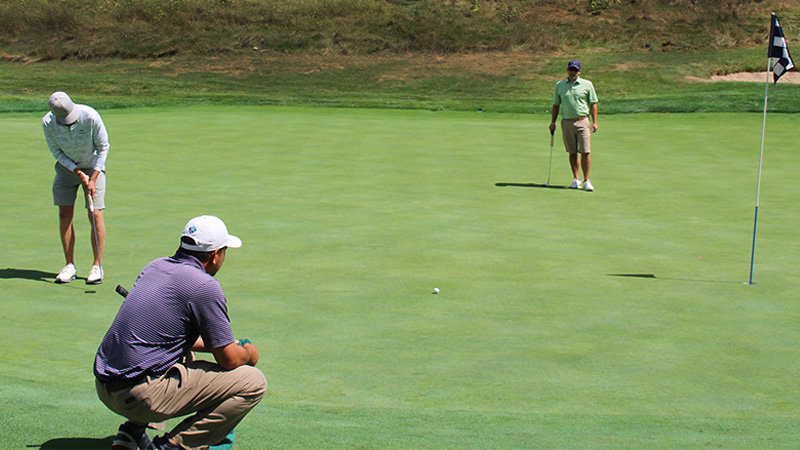CSGA (April 26, 2020) With the same resilience that they showed after 9/11 and the Great Recession, golfers are ready to get back to normal. And while cautious, they are, according to new research, more ready than most leisure consumers to return to the swing of things.
“Golfers have often shown resilience and they are showing it again,” said Jon Last, President of Sports and Leisure Research Group, which studies travel and sports markets, and has for a decade produced the annual state of the industry report at the PGA Show. “They tend to be more bullish. They tend to bounce back very quickly.”
Last’s company has undertaken special research during the pandemic, measuring consumer confidence about travel, attendance at sports events, and participation. It creates its Back-to-Normal Barometer with Engagious and ROKK, companies specializing in messaging and communication.
In results so far, golfers’ optimism ranks near the top.
“In terms of confidence, golf fans are right up there with Mixed Martial Arts,” said Last, “near the top of all sports. I think that’s partly because both of those two sports were early in drawing a line in the sand and saying this is when we will be going back. So golfers had something to anticipate and look forward to.”
That is not to say, Last adds, that golfers are not cautious.
“One of the numbers that blew us away in the first wave of the [pandemic] research was that less than half of golfers were willing to go right out and play. In the second wave that is slightly more, at least half of golfers willing to play. But that was surprising to me. They are anxious, but not reckless.”
Last’s group measures responses from some 5,000 leisure-activity consumers and will, every two weeks or so through July, present a Back-to-Normal Barometer briefing that will be available Tuesday at three times during the day. Register here: Tuesday, April 28 @ 10 a.m. EDT
Even in the first wave of research—and the pandemic—Last says, golfers tended to be more optimistic than most consumers. Only about a quarter of leisure consumers showed confidence that things would soon be back to normal. Golfers measured about 30 per cent. 'Comparing travel and leisure attitudes in September 2001 and July 2009 to today finds more consumer hesitancy now about returning to those activities. But the industry’s silver lining is a majority of customers will be willing to return to airplanes, hotels, and event venues once multiple conditions have been met,” said Last wrote in his first-wave report.
“There are a couple of things that will greatly affect the rate of return to normal,” Last said this week. “The first is assurance from health authorities. It is not enough for industry officials to say things are okay. So to the extent that they can, courses and clubs should connect their communications and requirements on those from health authorities, and they should communicate that often. The way courses and facilities communicate that they are taking precautions will be an important factor. The second, of course, is whether progress is made on a vaccine.”
If history is any indicator, golfers will throw off the shackles of restriction more quickly than most leisure consumers. “After 9/11, up to 70 per cent of golfers were willing to travel by November of that year,” said Last. “That was much higher than the average population.”
That said, there will be damage to the golf economy that can’t be repaired, says Last. Greens fees and especially equipment sales have taken a major hit, perhaps 20 per cent of the year’s revenue. “At the PGA Show this year we presented the most positive report in 12 years. Although we thought that unit sales might continue to struggle, we were confident revenue would be up. Now that’s all changed.”
Joe Beditz, President and CEO of the National Golf Foundation, says that just how much of a hit the industry will take is difficult to predict now. “Everybody is guessing right now. In the unlikely event that we get this virus under control sooner rather than later, then golf, in the long run, will probably not change all that much. There will be an economic shock, for sure. We’ll see more golf course closures than usual, and “usual” has meant “lots” over the past few years. Real estate developers will pick up the land which will be redeveloped at some point. If you can see a bright side to this it’s that the supply/demand correction in golf will accelerate and come to an end sooner with equilibrium being reached in more and more markets.”
Beditz and Last agree that the hit the industry takes will depend on a couple of things. First, the length of the crisis. “Parts of the golf business, like equipment manufacturing and retail, will eventually shake it off,” said Beditz, “but the longer the crisis continues the longer it’s going to take for those sectors to return to “normal.”
Another factor is the fear of a second wave of infections. “If there should be evidence of another wave, that would be a nightmare,” said Last. “Already more than half of people in our survey are worried that it could happen.”
As with every industry these days, and especially in the travel and restaurant fields, the extent to which change will endure remains to be seen. “Will the game itself change? I don’t think so, not in any essential way,” said Beditz. “I’d say the game has withstood the test of time, wouldn’t you? Most core golfers will return to ‘golf as usual.’ But what you might see, at least I hope, are some golf facilities willing to try new ways to present themselves to their communities. The need for more customers might just drive more innovative and effective marketing and an improved customer experiences at local golf courses. If this happens on any kind of significant scale, then history may view this period as a time when golf woke.”








